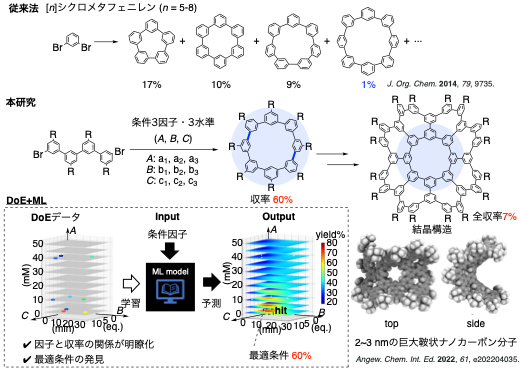Disclaimer: machine translated by DeepL which may contain errors.
~ Message from a graduate student~.
From design to synthesis of beautiful nanocarbon molecules
 |
| Department of Chemistry 2nd Year Doctoral Student |
| Birthplace Kyoto |
| High School Odei Jogakuin High School |
| Faculty Faculty of Science and Engineering, Sophia University |
The history of nanocarbons is indeed interesting. It started with the discovery of fullerene C60. At that time, graphite and diamond were thought to be the only two allotropes of carbon. However, in 1985, Harold Kroto, Richard Smalley, and others, while researching carbon materials existing in outer space, accidentally discovered fullerene C60, which led to the Nobel Prize in Chemistry in 1996 and had an impact that overturned common sense around the world. This discovery led to the expansion of the new field of "nanocarbons" such as carbon nanotubes and graphene. Since it exhibits high electron transport performance, it is still being actively researched for applications such as semiconductor materials. However, it is still difficult to improve the performance of nanocarbons because they are produced as "mixtures" by top-down methods, and a long road is needed to reach their application. In other words, one of the major challenges is to achieve bottom-up synthesis as a "single" molecule with a unique structure and to increase its yield.
I have been interested in the creation of highly functional materials for a long time. In fact, during my undergraduate years, I was doing research on crystal engineering for solar cell applications at a different university. However, with the current method of growing crystals as a mixture, performance degradation due to physical defects cannot be avoided. In other words, the bottom-up approach to synthesize a single molecule and fabricate homogeneous crystals is the solution to the problem.
In my current laboratory, we are developing research on the design and synthesis of "nanocarbon molecules" using 1,3,5-trisubstituted benzene "phenyne" instead of sp2-carbon, and have reported many of them. I chose my current laboratory because I wanted to synthesize unprecedented nanocarbon molecules by my own hands.
My research aims to improve the yield of synthesis of novel nanocarbon molecules. I have developed a method to efficiently optimize reaction conditions to selectively obtain [n]cyclometaphenylene (CMP), which is used as an important intermediate for nanocarbon molecules, in high yield. In the conventional method, the yield after [8]CMP is significantly lower than 1%. Therefore, we decided to optimize the conditions for dimerization reactions by reducing the number of reaction sites by using a feedstock with four phenynes connected in advance. We used an avant-garde method based on data science to effectively collect data with a minimum number of experiments using design of experiments (DoE) and to draw a 3D heat map using machine learning (ML) predictions. This method has led to the achievement of high-yield synthesis of novel giant nanocarbon molecules, improving the yield from only 1% to 60% with the conventional method.

This study: Optimization of reaction conditions and synthesis of giant saddle-shaped nanocarbon molecules using the DoE+ML strategy
I myself was a complete beginner in statistics and programming when I started working in data science. Fortunately, I was able to carry out my research with my seniors who had a wealth of knowledge, but it was hard to find time to learn DoE and ML while conducting many experiments. In addition, I had many in-depth discussions with my seniors and Professor before I came up with the idea for the 3D heat map.
Thus, we have not only synthesized novel giant nanocarbon molecules, but also established a new method through our efforts to reach this goal. Currently, he is working on the synthesis of even more challenging nanocarbon molecules, and is making efforts every day to reach an unprecedented level of achievement.
The Rigaku-bu News, November 2023


